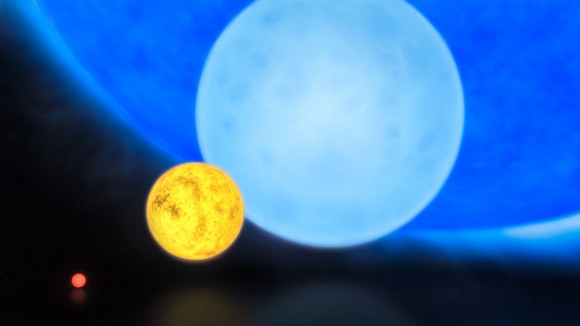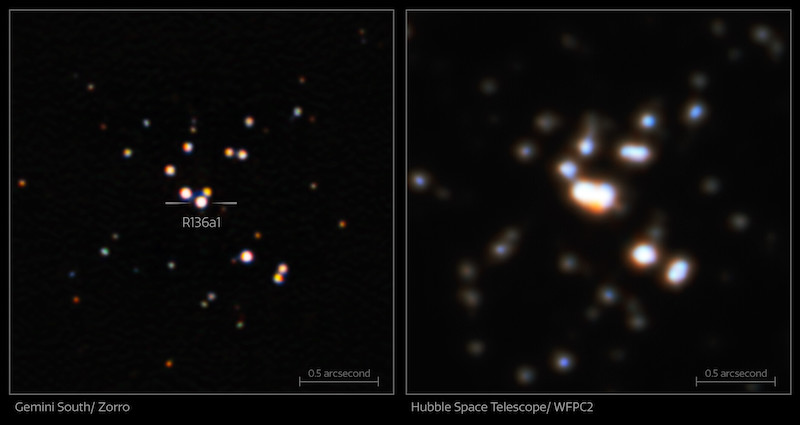
The biggest monster star
There are very heavy stars. And there are gigantic stars. In terms of sheer size, the star UY Scuti is – as far as we know – the biggest star known. It’s only about 7 to 10 times the sun’s mass, but has a radius more than 1,700 greater than the sun.
While there is currently no competition for UY Scuti as the largest star, there is uncertainty about which star is the most massive star. All of the contenders are nearly twice as massive as what astronomers thought was possible.
Many sources continue to list R136a1 as the heaviest star known at 250 solar masses. However, a recent study in 2022, puts its mass between 170 – 230 times more massive than our sun. Thus, enabling two other stars to edge it out of the top spot on the massive star list. However, that list is dated 2016 and states the masses listed on it are uncertain.
So currently topping the massive star list at 250 solar masses is Westerhout 49-2. Although, its mass may vary by as much as 120 solar masses – plus or minus – from that figure.
Then, another contender for the most massive star is BAT99-98. It’s estimated to be about 226 solar masses. And since its mass isn’t listed with a plus or minus range, it could easily be the most massive star.
Of course, regardless of which one tops the massive star list, all of them are very massive stars!
Read more about these monster stars below …
UY Scuti is just plain big
UY Scuti is located some 9,500 light-years away. And it’s the biggest star known, in terms of sheer physical size. The fact is that – for stars – mass and physical size don’t always go hand in hand. Consider that great mass means stronger gravity. And stronger gravity means a greater inward pull for a star. So being super massive might not correlate to being super big.
UY Scuti has a relatively modest mass. It’s only about 7 to 10 times more massive than our sun. But its radius is about 1,700 times greater than the radius of our sun. That would make this star nearly 8 astronomical units across. That’s eight times 93 million miles (150 million km), the distance between our Earth and sun. So, this single star is so large that its outer surface would extend far beyond the orbit of the planet Jupiter (which lies about five times farther from the sun than Earth).
Or look at it this way. More than a million Earths could fit inside the sun. But some 5 billion suns could fit inside a sphere the size of UY Scuti.
The other big stars
Who are the other candidates for the biggest star? They would include NML Cygni, whose estimated distance is about 5,300 light-years way and whose radius is between 1,183 and 2,770 times greater than that of our sun. A recent study of this star suggested that it’s an unusual hypergiant star cocooned within a nebula and severely obscured by dust. So we don’t know its size exactly, and the upper part of the range would make it larger than UY Scuti.
Another hypergiant star is WOH G64, also in the Large Magellanic Cloud, and thus located at about 160,000 light years from Earth. At an estimated 1,540 times the sun’s radius, this star is thought to be the largest star in the Large Magellanic Cloud, in terms of sheer physical size. And, again, we’re talking size here, not mass. This star is about 25 times the sun’s mass.
The heaviest stars
Currently topping the most massive star list at 250 solar masses is Westerhout 49-2. Although, its mass may vary by as much as 120 solar masses – plus or minus – from that figure. It’s located 36,200 light-years away in the constellation of Aquila the Eagle. And it’s over four million times more luminous than our sun with a surface temperature of 63,440 degrees F (35,226 C). However, it’s important to note, it could be a binary star system so its estimated mass could be from a combination of two stars.
Second on the most massive star list is BAT99-98. It’s located 165,000 light-years distant in the Large Magellanic Cloud near the R136 star cluster. It’s estimated to be about 226 solar masses and is a Wolf-Rayet star. Also, it’s about five million times more luminous than our sun with a surface temperature of 80,540 degrees F (44,726 C).
Finally, the former champion, now third on the list, is R136a1. It’s located in the Large Magellanic Cloud at about 163,000 light-years away. R136a1 is what’s known as a Wolf–Rayet star. And has a mass between 170 – 230 times the mass of the sun. Its surface temperature is over 100,000 degrees F (55,538 degrees C). And it’s almost five million times more luminous than our sun
In addition to being on the massive star list, all three of these stars are among the most luminous stars.
How the most massive stars form
For decades, theories have suggested that no stars can be born by ordinary processes above 150 solar masses. So how did these stars grow so large? And why aren’t monster stars scattered throughout space?
One idea is that supermassive stars like R136a1 form through mergers of multiple stars. In 2012, astronomers at the University of Bonn suggested that the ultramassive stars in the Large Magellanic Cloud – such as R136a1 – were created when lighter stars in tight double-star systems merged.
Still, double-star systems are common. So why don’t we see more super-sized stars? The astronomers in Bonn say it’s because these stars formed under special conditions – in a densely packed star cluster. And in a closely packed star cluster, double-stars are more likely to encounter each other and merge.
But if these ultramassive stars form in this way, why don’t we see more of them? After all, multiple star systems are common throughout space, while monster stars are few and far between.
The answer may be that monster stars don’t live very long. They evolve very quickly in contrast to less massive stars like our sun. They end their lives in violent supernova explosions.
Imagine how bright they’d be nearby
As you can see, there are extremely heavy stars … and there are simply gigantic stars. What makes a star big might be its mass or its physical size. And either way, it’s fun to imagine what it would be like to have one of these stars relatively close to us in space … say, the distance to the nearest star system, Alpha Centauri, only four light-years away.
At that distance, any of these stars would blaze in our night sky!


Bottom line: Stars are considered big based on their sheer physical size or their mass. In terms of sheer size, UY Scuti is the biggest known star. As for the most massive, currently Westerhout 49-2 tops the list, but different sources vary on which star they list as most massive.
The post Biggest monster star! And the heaviest stars first appeared on EarthSky.
from EarthSky https://ift.tt/SnshzRB

The biggest monster star
There are very heavy stars. And there are gigantic stars. In terms of sheer size, the star UY Scuti is – as far as we know – the biggest star known. It’s only about 7 to 10 times the sun’s mass, but has a radius more than 1,700 greater than the sun.
While there is currently no competition for UY Scuti as the largest star, there is uncertainty about which star is the most massive star. All of the contenders are nearly twice as massive as what astronomers thought was possible.
Many sources continue to list R136a1 as the heaviest star known at 250 solar masses. However, a recent study in 2022, puts its mass between 170 – 230 times more massive than our sun. Thus, enabling two other stars to edge it out of the top spot on the massive star list. However, that list is dated 2016 and states the masses listed on it are uncertain.
So currently topping the massive star list at 250 solar masses is Westerhout 49-2. Although, its mass may vary by as much as 120 solar masses – plus or minus – from that figure.
Then, another contender for the most massive star is BAT99-98. It’s estimated to be about 226 solar masses. And since its mass isn’t listed with a plus or minus range, it could easily be the most massive star.
Of course, regardless of which one tops the massive star list, all of them are very massive stars!
Read more about these monster stars below …
UY Scuti is just plain big
UY Scuti is located some 9,500 light-years away. And it’s the biggest star known, in terms of sheer physical size. The fact is that – for stars – mass and physical size don’t always go hand in hand. Consider that great mass means stronger gravity. And stronger gravity means a greater inward pull for a star. So being super massive might not correlate to being super big.
UY Scuti has a relatively modest mass. It’s only about 7 to 10 times more massive than our sun. But its radius is about 1,700 times greater than the radius of our sun. That would make this star nearly 8 astronomical units across. That’s eight times 93 million miles (150 million km), the distance between our Earth and sun. So, this single star is so large that its outer surface would extend far beyond the orbit of the planet Jupiter (which lies about five times farther from the sun than Earth).
Or look at it this way. More than a million Earths could fit inside the sun. But some 5 billion suns could fit inside a sphere the size of UY Scuti.
The other big stars
Who are the other candidates for the biggest star? They would include NML Cygni, whose estimated distance is about 5,300 light-years way and whose radius is between 1,183 and 2,770 times greater than that of our sun. A recent study of this star suggested that it’s an unusual hypergiant star cocooned within a nebula and severely obscured by dust. So we don’t know its size exactly, and the upper part of the range would make it larger than UY Scuti.
Another hypergiant star is WOH G64, also in the Large Magellanic Cloud, and thus located at about 160,000 light years from Earth. At an estimated 1,540 times the sun’s radius, this star is thought to be the largest star in the Large Magellanic Cloud, in terms of sheer physical size. And, again, we’re talking size here, not mass. This star is about 25 times the sun’s mass.
The heaviest stars
Currently topping the most massive star list at 250 solar masses is Westerhout 49-2. Although, its mass may vary by as much as 120 solar masses – plus or minus – from that figure. It’s located 36,200 light-years away in the constellation of Aquila the Eagle. And it’s over four million times more luminous than our sun with a surface temperature of 63,440 degrees F (35,226 C). However, it’s important to note, it could be a binary star system so its estimated mass could be from a combination of two stars.
Second on the most massive star list is BAT99-98. It’s located 165,000 light-years distant in the Large Magellanic Cloud near the R136 star cluster. It’s estimated to be about 226 solar masses and is a Wolf-Rayet star. Also, it’s about five million times more luminous than our sun with a surface temperature of 80,540 degrees F (44,726 C).
Finally, the former champion, now third on the list, is R136a1. It’s located in the Large Magellanic Cloud at about 163,000 light-years away. R136a1 is what’s known as a Wolf–Rayet star. And has a mass between 170 – 230 times the mass of the sun. Its surface temperature is over 100,000 degrees F (55,538 degrees C). And it’s almost five million times more luminous than our sun
In addition to being on the massive star list, all three of these stars are among the most luminous stars.
How the most massive stars form
For decades, theories have suggested that no stars can be born by ordinary processes above 150 solar masses. So how did these stars grow so large? And why aren’t monster stars scattered throughout space?
One idea is that supermassive stars like R136a1 form through mergers of multiple stars. In 2012, astronomers at the University of Bonn suggested that the ultramassive stars in the Large Magellanic Cloud – such as R136a1 – were created when lighter stars in tight double-star systems merged.
Still, double-star systems are common. So why don’t we see more super-sized stars? The astronomers in Bonn say it’s because these stars formed under special conditions – in a densely packed star cluster. And in a closely packed star cluster, double-stars are more likely to encounter each other and merge.
But if these ultramassive stars form in this way, why don’t we see more of them? After all, multiple star systems are common throughout space, while monster stars are few and far between.
The answer may be that monster stars don’t live very long. They evolve very quickly in contrast to less massive stars like our sun. They end their lives in violent supernova explosions.
Imagine how bright they’d be nearby
As you can see, there are extremely heavy stars … and there are simply gigantic stars. What makes a star big might be its mass or its physical size. And either way, it’s fun to imagine what it would be like to have one of these stars relatively close to us in space … say, the distance to the nearest star system, Alpha Centauri, only four light-years away.
At that distance, any of these stars would blaze in our night sky!


Bottom line: Stars are considered big based on their sheer physical size or their mass. In terms of sheer size, UY Scuti is the biggest known star. As for the most massive, currently Westerhout 49-2 tops the list, but different sources vary on which star they list as most massive.
The post Biggest monster star! And the heaviest stars first appeared on EarthSky.
from EarthSky https://ift.tt/SnshzRB

Aucun commentaire:
Enregistrer un commentaire